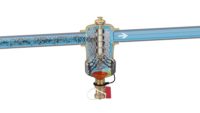Color me a skeptic. One of our supply house salesmen constantly hounded me regarding citrus-based no-salt water softeners. I never did buy into the sales literature hype, so we never installed any. Linda, a best friend of my wife, lives in Las Vegas and recently asked for my advice regarding her citrus-based water "softener." Apparently, mold and/or bacteria gained a foothold inside the filters and its head, causing concern.
Here’s the exchange with the name "Widget" substituted for the manufacturer’s name.
"Lois copied me on your question regarding your Widget water conditioner. If you used a diluted bleach solution to clean your filter housing, that should be effective in removing the bacteria and/or mold so that it doesn't reappear. That's assuming the growth is isolated to the Widget and not in the incoming water line to reseed the filter housing. Although Widget calls the cartridge citrus-based filtration a softener, it isn't really a water softener, but rather a water conditioner. There are no actual salt-free water softeners no matter what the manufacturers claim. They are good at reducing or eliminating scale and your Widget slightly lowers the pH of the water.
"From what I see regarding the Widget pricing, they're on par with salt-based water softeners. We always used XYZ brand metered water softeners because they are manufactured in a neighboring town. If you decide to switch to a salt-based water softener, I would strongly urge you to have one installed that actually meters the water used so that it only regenerates when the resin bead bed will have nearly exhausted its ability to exchange ions with the hard water minerals. The brine solution absorbs the hard water mineral ions, which removes them from the resin bead bed so that it can go back to exchanging ions with the hard water.
"From what I have read about water in Vegas, I understand it is somewhat aggressive. There was a class action lawsuit against a PEX tubing manufacturer whose brass connectors were degraded by the Vegas water that removed the zinc from the fittings, which created leaks that damaged homes and businesses.
"Looking online at the Las Vegas Valley water company report, they have a pH of 7.8 and 16 grains hardness. That's alkaline and very hard water. A salt-based water softener would knock down the hardness and also remove the minerals causing the hard water whereas the Widget does not lower the pH and the minerals remain, but no longer — they claim — cause scaling or scale buildup in water heaters.
Trust is so elusive today with misinformation washing over us every second of the day! The literature from multiple salt-free water conditioners stating they are softeners is prolific. There are also other sites, including salt-free water conditioning manufacturers stating there is no such thing as a salt-free water softener. You can, therefore, believe whomever you want to believe, so there!
"If you have been satisfied with the Widget system, then I'd say keep on using one. I'd also recommend contacting a testing lab to obtain a sterile sample vial to have the mold/bacteria collected and tested if it reappears. You could also contact Widget, but from the consumer complaints I just read online, that might not provide a satisfactory response."
Linda’s reply: "Very interesting, Dave. Thank you for getting back to me so that now I have a lot of information to work with. I probably do need to remove the filter again and clean it with bleach as I’ve done before then I can decide whether I’m going to go ahead and get a true water softener. I was aware of Widget and that it isn’t really a water softener, but it is citrus based and what it does is keeps the minerals from clinging to each other thereby reducing buildup on hot water heaters, and all of the plumbing. I would say it really does work. We had to replace our hot water heater twice within five years of moving here. We had a water softener previously but probably not a good one, and my Dave, thinking that if you add salt as directed, then more salt is probably better. I don’t think that was the case, haha. Have been here 17 years now so the new Widget really has done well for us since we haven’t had to get another water heater since. Now I’m sure since I said that, it will be going out soon. Maybe that will be the time to invest in a new water softener. Thanks again Dave for the information. Unfortunately, not always sure who to trust. It’s true about the PEX tubing. Our HOA did file a lawsuit. We had a leak inside our wall which caused mold to grow on one of our walls in the guest bedroom, which was repaired free of charge thank goodness."
Trust is so elusive today with misinformation washing over us every second of the day! The literature from multiple salt-free water conditioners stating they are softeners is prolific. There are also other sites, including salt-free water conditioning manufacturers stating there is no such thing as a salt-free water softener. You can, therefore, believe whomever you want to believe, so there!
The big bug-a-boo, of course, is that salt-based water softeners increase the sodium content in the potable drinking water. The other issue is that actual water softeners remove dissolved salts of such metals as calcium, iron or magnesium and substitute sodium ions from the exchange that takes place in the resin bead media within the softener. If customers want to replace the minerals, you can install a remineralizer, although that is more commonly utilized for Reverse Osmosis (RO) water to improve taste and odor.
So how much sodium is added to softened water and how much is too much? Linda’s water quality report indicates she had very hard water at 16-grains of hardness. I was always taught that anything above 4-grains is considered hard water and eligible for installation of a salt-based water softener.
According to the WQA (Water Quality Association), for every grain of hardness there will be 30mg of sodium added in a gallon of water after it has been softened.
16 Grains x 30mg = 480mg in a Gallon (128oz)
480mg Sodium / 128oz = 3.75 mg per oz
3.75mg * 8oz = 30mg
Do you like to eat bread? I love toast! One slice of white bread contains, on average according to MyDietMealPlanner.com, 170mg of sodium. Well, that sounds like a lot of sodium, and for folks like me with high blood pressure, that is the concern the no-salt water conditioning (note: I did not say water softener) folks are constantly beating their drums about. I would, too, if I were them.
So how much sodium is too much on a daily basis? According to the FDA (Food and Drug Administration), Dietary Guidelines for Americans recommends adults limit sodium intake to less than 2,300 mg per day — that's equal to about 1 teaspoon of table salt! Well then, a sodium-based water softener doesn’t seem so bad, now does it? However, take that with a grain of salt, because the same FDA states: Most Americans eat too much of it — and they may not even know it. Americans eat on average about 3,400 mg of sodium per day.
Have you ever tried to shop for low-sodium canned goods? If not, I can tell you, from personal experience in striving to get my blood pressure under control, it’s not an easy get. What we found was lowered sodium content was offset by higher sugar content! Diabetics beware.
The long and the short of it was this for my mechanical contracting firm. I saw myself as a consultant and educator for our customers, rather than a sales guy. Arm them with the facts and help them understand the Widget we were proposing and, then, let them make an informed decision based on their needs, wants and concerns. That’s why my close rate was exceptionally high. You listen; they tell; you sell!




